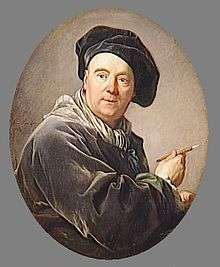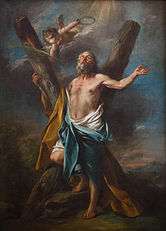Charles-André van Loo

Carle or Charles-André van Loo (French pronunciation: [ʃaʁləs.ɑ̃dʁe vɑ̃ lɔo]; 15 February 1705 – 15 July 1765) was a French subject painter, son of the painter Louis-Abraham van Loo, a younger brother of Jean-Baptiste van Loo and grandson of Jacob van Loo. He was the most famous member of a successful dynasty of painters of Dutch origin. His oeuvre includes every category: religion, history painting, mythology, portraiture, allegory, and genre scenes.[1]
Life

He was born in Nice, then part of the Duchy of Savoy. Van Loo followed his brother Jean-Baptiste to Turin, and then to Rome in 1712, where he studied under Benedetto Luti and the sculptor Pierre Legros. After leaving Italy in 1723, he worked in Paris, studied at the Académie Royale, where he gained first prize for drawing in 1723, and received the first prize for historical painting in 1727—as did his future rival François Boucher.
After again visiting Turin in 1727, he was employed by king Victor Amadeus II of Sardinia, for whom he painted a series of subjects illustrative of Tasso. In 1734 he settled in Paris, and in 1735 became a member of the Académie Royale de Peinture et de Sculpture and rose rapidly in the hierarchy of the academy. Madame de Pompadour and the French court were taking the artist under their patronage. He was decorated with the Order of Saint Michael and named First Painter to king Louis XV of France in 1762. He was a most successful court painter but his portraits as well as history paintings also enjoyed an enormous success throughout all Europe. He died in Paris on 15 July 1765.[2][3]
Work
By his simplicity of style and correctness of design, the result of his study of the great Italian masters, he did much to purify the modern French school; but the contemporary praise that was lavished upon his productions now appears undue and excessive. His patrons included members of the court, the Gobelins factory, private individuals, and the church. In the ensuing centuries, Van Loo's critical fortune has plummeted, although his ability remains admirable, and the quality and variety of his work command respect. His Marriage of the Virgin is preserved in the Louvre.[4][5]
Paintings
 Saint Andrew
Saint Andrew- Portrait of Innocente Guillemette de Rosnyvinen de Pire, 1762
 Perseus and Andromeda
Perseus and Andromeda_-_Google_Art_Project.jpg) Marie Leczinska Queen of France (1703-1768), 1747, Versailles,
Marie Leczinska Queen of France (1703-1768), 1747, Versailles,.jpg) Louis XV, (1710-1774)
Louis XV, (1710-1774) La Marquise de Pompadour , 1754-1755, Versailles, Petit Trianon.
La Marquise de Pompadour , 1754-1755, Versailles, Petit Trianon. The Three Graces, 1763
The Three Graces, 1763 Portrait of William 1st Viscount Bateman
Portrait of William 1st Viscount Bateman_Mercury_and_Argus.jpg) 'Mercury and Argus
'Mercury and Argus The Victory of Alexander over Porus
The Victory of Alexander over Porus 'Theseus Taming the Bull of Marathon
'Theseus Taming the Bull of Marathon Baccus et Ariane
Baccus et Ariane The Adoration of the Magi
The Adoration of the Magi
References
- ↑ "Charles-André van Loo Encyclopædia Britannica". global.britannica.com. Retrieved March 7, 2015.
- ↑ "Charles-André van Loo Encyclopædia Britannica". global.britannica.com. Retrieved March 7, 2015.
- ↑ "LACMA Charles-André Vanloo". collections.lacma.org. Retrieved March 7, 2015.
- ↑ "Charles-André van Loo Encyclopædia Britannica". global.britannica.com. Retrieved March 7, 2015.
- ↑ "LACMA Charles-André Vanloo". collections.lacma.org. Retrieved March 7, 2015.
-
 This article incorporates text from a publication now in the public domain: Chisholm, Hugh, ed. (1911). "Vanloo, Charles Andrew". Encyclopædia Britannica. 27 (11th ed.). Cambridge University Press. p. 895.
This article incorporates text from a publication now in the public domain: Chisholm, Hugh, ed. (1911). "Vanloo, Charles Andrew". Encyclopædia Britannica. 27 (11th ed.). Cambridge University Press. p. 895.
External links
![]() Media related to Charles André van Loo at Wikimedia Commons
Media related to Charles André van Loo at Wikimedia Commons